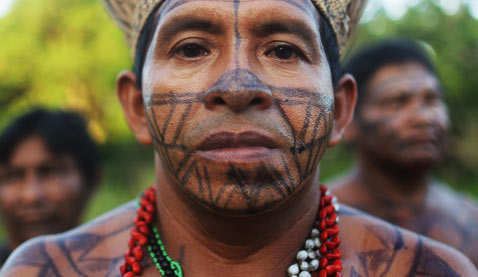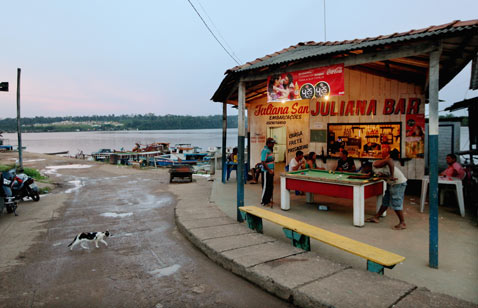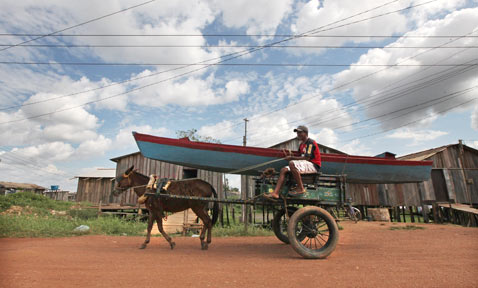Brazil's Belo Monte Dam to Displace Thousands in Amazon
Belo Monte Dam will be the world's third-largest hydroelectric project and will displace up to 20,000 people while diverting the Xingu River and flooding as much as 230 square miles of rainforest in Brazil. The Brazilian government says residents forced to relocate will be compensated and that most will benefit from the relocation. Opponents of the dam are skeptical of this claim.
While environmentalists and indigenous groups oppose the dam, many Brazilians support the project. The Brazilian Amazon, home to 60 percent of the world's largest forest and 20 percent of the Earth's oxygen, remains threatened by the rapid development of the country. The area is currently populated by over 20 million people and is challenged by deforestation, agriculture, mining, a governmental dam-building spree, illegal land speculation including the occupation of forest reserves and indigenous land and other issues.
Photographer Mario Tama is documenting the residents of Altamira, a town which will soon be underwater.

Construction continues at the Belo Monte dam complex in the Amazon basin on June 15, 2012 near Altamira, Brazil.
The controversial project is one of around 60 hydroelectric projects Brazil has planned in the Amazon to generate electricity for its rapidly expanding economy.

Indigenous men look on during a ceremony honoring the Xingu River before the start of the Xingu +23 event that gathers resisters of the Belo Monte dam project in the Amazon basin, June 13, 2012 in Santo Antonio, near Altamira, Brazil.
Over 100 heads of state and tens of thousands of participants and protesters will descend on Rio de Janeiro, Brazil, later this month for the Rio+20 United Nations Conference on Sustainable Development or 'Earth Summit'. Host Brazil is caught up in its own dilemma between accelerated growth and environmental preservation.

Residents who are being displaced by the Belo Monte dam and supporters stand atop a temporary earthen dam at the Belo Monte construction site after removing a strip of earth to restore the flow of the Xingu River as a protest against the construction on June 15, 2012 near Altamira, Brazil.

People Bathe and Wash Items in a Stream leading toe the Xingu River near the area where the Belo Monte Dam complex is under construction in the Amazon Basin , June 16, 2012, in Altamira, Brazil.

Rodrigo Galveia and Gleciane pose in their home in the Invasao dos Padres neighborhood, which stands to be flooded by the Belo Monte dam, on June 15, 2012 in Altamira, Brazil.

Protesters demonstrate against the Belo Monte dam project near the area where the dam complex is under construction in the Amazon basin on June 15, 2012 in Altamira, Brazil.

Men play pool in an area that will be flooded when the dam is completed near the site where the Belo Monte dam complex is under construction in the Amazon basin on June 14, 2012 in Altamira, Brazil.

Farmer Joao Volveriso poses in a market where he sells goods near the site where the Belo Monte dam complex is under construction in the Amazon basin on June 17, 2012 in Altamira, Brazil.

A resident transports his boat with a mule in the low-lying Invasao dos Padres neighborhood, which stands to be flooded by the Belo Monte dam, on June 16, 2012 in Altamira, Brazil.

Residents gather in the Invasao dos Padres neighborhood, which stands to be flooded by the Belo Monte dam, on June 15, 2012 in Altamira, Brazil.

Indigenous people from the Kuruaia and Xipaia tribes march during a ceremony honoring the Xingu River before the start of the Xingu +23 event that gathers resisters of the Belo Monte dam project in the Amazon basin on June 13, 2012 in Santo Antonio, near Altamira, Brazil. Santo Antonio is adjacent to where the Belo Monte dam complex is under construction and the entire community will be expropriated for the construction. Around 60 families originally lived in Santo Antonio but now only about ten families remain. Xingu +23 is an event running parallel to the United Nations Rio + 20 event and marks 23 years since the first meeting of indigenous peoples opposed to the dam in 1989.
All Images By Mario Tama/Getty Images
More Work By Mario - MARIOTAMA.COM